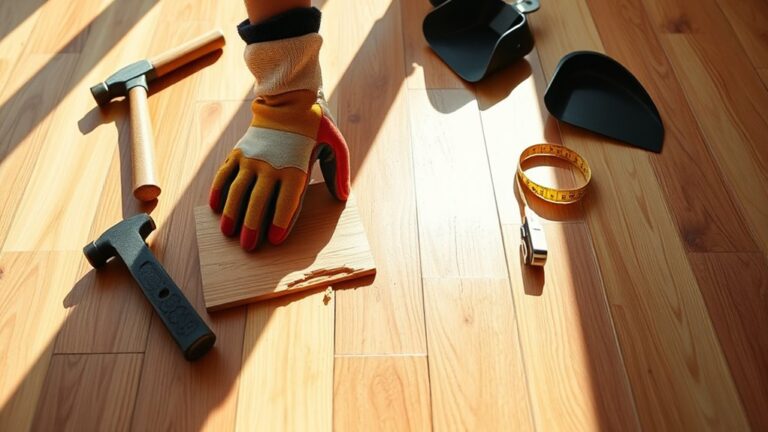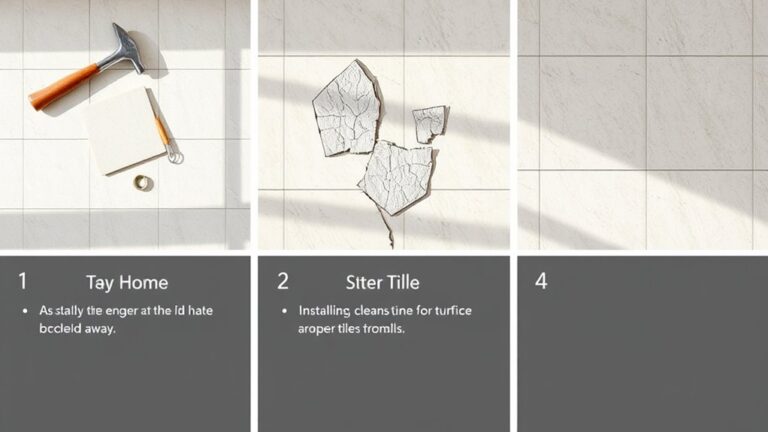To enhance energy efficiency with radiant heating floors, start by ensuring proper insulation using high-quality materials to minimize heat loss. Install a programmable thermostat to refine heating based on occupancy, preventing energy waste. Utilize zoning systems for tailored heating in different areas, which can greatly lower bills. Regular maintenance, like checking for leaks and cleaning the floors, is essential for peak performance. Choose flooring materials like ceramic tile that conduct heat well, while avoiding thick carpets that hinder efficiency. These steps can lead to comfort and savings, and you might find even more valuable insights ahead.
Understanding Radiant Heating Systems
When it comes to heating your home, understanding radiant heating systems is vital for making informed decisions. These systems primarily consist of two types: electric and hydronic. Electric systems use cables or mats installed beneath your flooring, while hydronic systems circulate hot water through pipes. Knowing the difference can help you choose the right system for your needs.
Hydronic radiant floor systems are often more energy-efficient, particularly in larger spaces. They can integrate seamlessly with renewable energy sources like solar panels, reducing your reliance on traditional energy sources. On the other hand, electric radiant systems are typically quicker and easier to install, making them ideal for smaller areas such as bathrooms or home additions.
To maximize the efficiency of your radiant heating systems, proper insulation is essential. Insulation helps prevent heat loss, ensuring that the warmth generated stays within your home where it belongs. Additionally, utilizing programmable thermostats can greatly enhance the performance of these systems. With smart technology, you can schedule heating based on your daily routines and occupancy patterns, optimizing energy consumption.
Benefits of Energy Efficiency
When you prioritize energy efficiency in your radiant heating system, you're not just cutting costs; you're also making a positive impact on the environment. By reducing energy consumption, you lower your utility bills and decrease your carbon footprint. This dual benefit highlights why adopting energy-efficient practices is both a practical and ethical choice for homeowners.
Cost Savings Potential
Many homeowners find that switching to radiant heating floors can lead to significant cost savings. With energy efficiency at the forefront, radiant heating systems can provide energy savings of up to 30% compared to traditional forced-air systems. Here are some effective strategies to maximize those savings:
- Programmable Thermostats: Use smart thermostats to schedule heating for only occupied spaces, optimizing energy use during off-peak hours.
- Lower Thermostat Settings: Maintain comfortable temperatures at lower settings—6-8°F less—reducing energy consumption without sacrificing comfort.
- Individual Room Controls: Integrate individual room controls to tailor heating to different areas, enhancing efficiency and lowering utility bills.
- Zoning Systems: Implement zoning systems to manage heat distribution, allowing for reduced operational hours and maximizing energy efficiency throughout the day.
Environmental Impact Reduction
Energy-efficient radiant heating systems offer a compelling way to reduce your home's environmental impact while still providing comfort. By implementing these systems, you can cut your overall energy consumption by up to 30%. This significant reduction minimizes the carbon footprint typically associated with traditional heating methods. Radiant heating effectively distributes warmth at lower thermostat settings, allowing you to maintain a cozy indoor environment while using less energy, which contributes to decreased greenhouse gas emissions.
Using programmable and smart thermostats with radiant heating allows you to optimize heating schedules that align with your occupancy patterns, further enhancing energy efficiency. Plus, the elimination of ductwork in these systems prevents heat loss, reducing the environmental impact of wasted energy.
Integrating radiant heating with renewable energy sources, like solar panels, can further decrease reliance on non-renewable energy, promoting a more sustainable and eco-friendly home environment. By choosing energy-efficient radiant heating, you not only enhance your comfort but also take meaningful steps toward reducing your environmental impact, making a positive difference for the planet.
Proper Insulation Techniques
When setting up radiant heating floors, selecting the right insulation materials is essential for efficiency. You also need to take into account moisture barriers, especially if concrete moisture levels exceed 10%, to protect your system from damage. Adhering to best installation practices guarantees that your insulation performs at its best, maximizing warmth retention and comfort in your living space.
Insulation Materials Selection
Selecting the right insulation materials is vital for optimizing the efficiency of radiant heating floors. High-quality insulation can greatly reduce heat loss and enhance the performance of your radiant heating systems. Here are some key considerations to help you make the best choice:
- Choose Closed-Cell Foam or Rigid Foam Boards: These materials minimize thermal bridging and effectively prevent heat from escaping.
- Insulate Beneath the Heating System: Installing insulation between the concrete slab and heating elements is essential to stop heat absorption by the ground.
- Ensure Continuous Insulation: Gaps can lead to energy loss, so make sure your insulation is seamless to maximize energy savings.
- Upgrade Windows: Replacing single-pane windows with double or triple-pane options can greatly lower heat loss, supporting overall system efficiency.
Moisture Barrier Importance
Installing proper insulation materials can greatly enhance the performance of radiant heating floors, but without a moisture barrier, the system's efficiency may suffer. A moisture barrier is essential, especially when your system's installed over concrete slabs. If the concrete moisture exceeds 10%, this barrier prevents water vapor from rising and condensing, which can lead to mold growth and seriously damage your flooring.
Proper insulation beneath the heating elements minimizes heat loss, but the moisture barrier plays a significant role in maintaining system performance by reflecting heat upwards. This guarantees that radiant heat stays where it's needed most, enhancing energy conservation and reducing the energy required to maintain comfortable temperatures throughout your efficient home.
Installation Best Practices
Proper insulation techniques are essential for maximizing the efficiency of radiant heating floors. If you want to guarantee peak performance, follow these best practices to minimize heat loss and enhance energy efficiency:
- Install Quality Insulation: Use high-quality rigid foam boards beneath your radiant heating system to effectively reduce heat transfer to the subfloor, improving thermal performance.
- Apply Moisture Barriers: If the moisture content in concrete exceeds 10%, install moisture barriers. This prevents dampness from compromising both insulation effectiveness and heating efficiency.
- Maintain Continuous Insulation: Guarantee a continuous layer of insulation around the perimeter of the heating area. This helps prevent thermal bridging, which can lead to heat loss and uneven heating distribution.
- Follow Manufacturer Guidelines: Consult with professionals to adhere to installation practices for heating cables or tubing. Proper depth and spacing are critical for achieving maximum insulation and efficiency.
Smart Thermostat Usage
Utilizing smart thermostats can notably enhance the energy efficiency of radiant heating floors in your home. These devices allow you to automate and optimize your heating schedules, adjusting the temperature based on room occupancy. When spaces are unoccupied, smart thermostats can turn systems down, considerably reducing energy use and preventing wasted heat.
Adaptive thermostats take this a step further by fine-tuning the heating time variations between electric and hydronic systems. This guarantees that your radiant floor heating operates efficiently, tailored specifically to your setup. Additionally, with the use of timers and zoning systems, you can achieve independent temperature control in different rooms. This not only enhances comfort but also minimizes unnecessary energy expenditure in low-traffic areas.
Regularly monitoring your energy usage through smart thermostats can reveal patterns that lead to improved energy management. By identifying peak usage times and adjusting accordingly, you can maximize cost savings. One of the most effective strategies is leveraging off-peak hours; smart thermostats allow you to preheat your floors during these times, aligning your energy consumption with lower electricity rates.
Incorporating smart thermostats into your radiant heating system can lead to a more efficient, cost-effective way to maintain comfort in your home. By embracing this technology, you're not just saving money; you're also making a positive impact on your overall energy consumption.
Regular Maintenance Practices
When it comes to maintaining the efficiency of your radiant heating floors, regular maintenance practices play a significant role. By keeping your systems in check, you'll enhance energy efficiency and prolong the life of your radiant heating. Here are some essential maintenance tips to take into account:
- Inspect Hydronic Systems: Regularly check for leaks and verify that the pressure gauge is functioning correctly. This helps maintain peak performance and prevents water loss.
- Schedule Professional Inspections: For electric radiant systems, arrange annual professional inspections. This guarantees the safety and longevity of your heating cables or mats by identifying any signs of wear or damage.
- Keep Flooring Clean: Make certain your flooring is free from debris. Dirt or buildup can obstruct heat transfer, reducing the overall efficiency of your system.
- Avoid Heavy Furniture: Steer clear of placing heavy items on radiant heating elements. This can compress cables or mats, leading to reduced effectiveness and potential damage.
Additionally, maintaining proper insulation beneath the heating elements is essential to prevent heat loss. By verifying efficient insulation, you can assure that energy is used effectively to warm your space. Adopting these regular maintenance practices will not only improve the performance of your radiant heating but also contribute to a more comfortable and energy-efficient home. With a little effort, you can enjoy the benefits of radiant heating for years to come.
Cost Considerations
Considering the cost implications is vital when deciding on radiant heating systems for your home. While the initial installation costs can seem intimidating—ranging from $10 to $20 per square foot—these expenses may be quickly offset by long-term energy savings, thanks to the high efficiency of these systems. Hydronic systems, despite their hefty installation price (often exceeding $20,000 for larger areas), can drastically cut down your monthly energy bills compared to traditional heating.
When evaluating operational costs, electric radiant floor systems typically consume around 12 watts per square foot. This can lead to lower bills, especially if you take advantage of time-of-use rates, utilizing cheaper electricity during off-peak hours. It's important to keep in mind that the U.S. Department of Energy recognizes radiant heating's superior efficiency, making it a worthwhile investment that can enhance your home's value and potentially qualify you for rebates.
To maximize the benefits and mitigate costs, proper insulation and zoning are key. With adequate insulation, you can maintain comfort at lower temperatures, further reducing energy consumption. Zoning allows you to heat only the areas in use, enhancing efficiency and, ultimately, your energy savings. By carefully considering these cost factors, you can make an informed choice about radiant heating systems that aligns with your desire for freedom and comfort while managing your budget effectively.
Optimal Flooring Choices
Selecting the right flooring is a crucial factor in maximizing the efficiency of radiant heating systems. The effectiveness of your system largely depends on how well the flooring material conducts and retains heat. Here are some ideal flooring choices to take into account:
- Ceramic Tile: This is the most effective option for radiant heating systems. Its excellent heat conduction and ability to store warmth guarantee efficient heat distribution throughout your space.
- Laminated Wood Flooring: A solid choice for radiant heating, laminated wood is less prone to damage from heat compared to solid wood, making it a durable option that maintains aesthetic appeal.
- Vinyl and Linoleum: While these materials can be used with radiant heating, they're less efficient due to their insulating properties, which can hinder heat transfer. If you choose these, be mindful of their limitations.
- Carpeting: Thin carpets with dense padding work well with radiant heating. However, thick carpets can greatly reduce efficiency by acting as a barrier to heat flow, so be cautious in your selection.
If you have mixed floor coverings in a single area, think about installing separate heating controls. This helps enhance comfort, as different materials respond differently to radiant heat. By carefully selecting your flooring, you can improve the performance of your radiant heating systems and enjoy a cozy, energy-efficient home.
Frequently Asked Questions
What Is the Most Efficient Way to Use Radiant Floor Heat?
To maximize your radiant floor heat's efficiency, focus on fundamental factors like ideal insulation and smart thermostat settings. Utilize zoning systems to tailor temperatures, ensuring comfort where you need it while saving energy elsewhere. Regular maintenance tips can help maintain peak performance, preventing costly leaks. Consider your flooring materials and system types, as they impact installation costs and energy sources. By combining these strategies, you'll enjoy both warmth and savings seamlessly.
What Is the Most Efficient Way to Run Underfloor Heating?
To run your underfloor heating efficiently, consider your flooring materials and system controls. Opt for high-performance insulation during installation for ideal energy savings. Use programmable thermostats to manage heating schedules, reducing costs when rooms are unoccupied. Regular maintenance practices are essential to prevent heat loss. Conduct a cost analysis to gauge your system's performance and assess the environmental impact, ensuring you balance comfort with sustainability in your heating approach.
Do Radiant Floors Use a Lot of Electricity?
Radiant floors aren't excessive in their electricity use; they're more like a gentle stream, providing consistent warmth. With proper installation and maintenance tips, you can maximize comfort levels while enjoying cost savings. Various system types allow for tailored energy sources, minimizing environmental impact. If you encounter troubleshooting issues, refer to an installation guide. By understanding these nuances, you can embrace the freedom of efficient heating in your home without dread of high bills.
What Is the Best Temperature for Radiant Floor Heat?
When considering the best temperature for radiant floor heat, you'll find that a range of 70°F to 80°F is ideal, depending on your flooring materials and heating zones. Radiant floor benefits include energy savings and comfortable warmth. Make sure you keep consistent thermostat settings to avoid fluctuating costs. Installation costs can vary, so consider maintenance tips for longevity. Different system types may also affect efficiency, impacting your overall comfort and expenses.




